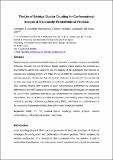The use of residual dipolar coupling for conformational analysis of structurally related natural products
Abstract
Determining the conformational preferences of molecules in solution remains a considerable challenge. Recently, the use of residual dipolar coupling (RDC) analysis has emerged as a key method to address this. Whilst to date the majority of the applications have focused on biomolecules including proteins and DNA, the use of RDCs for studying small molecules is gaining popularity. Having said that, the method continues to develop and here we describe an early case study of the quantification of conformer populations in small molecules using RDC analysis. Having been inspired to study conformational preferences by unexpected differences in the NMR spectra and the reactivity of related natural products, we showed that the use of more established techniques was unsatisfactory in explaining the experimental observations. The use of RDCs provided an improved understanding which, following use of methods to quantify conformer populations using RDCs, culminated in a rationalisation of the contrasting diastereoselectivities observed in a ketone reduction reaction
Citation
Lancefield , C S , Slawin , A M Z , Westwood , N J & Lebl , T 2015 , ' The use of residual dipolar coupling for conformational analysis of structurally related natural products ' , Magnetic Resonance in Chemistry , vol. 53 , no. 6 , pp. 467-475 . https://doi.org/10.1002/mrc.4213
Publication
Magnetic Resonance in Chemistry
Status
Peer reviewed
DOI
10.1002/mrc.4213ISSN
0749-1581Type
Journal article
Description
The authors would like to acknowledge the EPSRC for funding.Collections
Items in the St Andrews Research Repository are protected by copyright, with all rights reserved, unless otherwise indicated.

